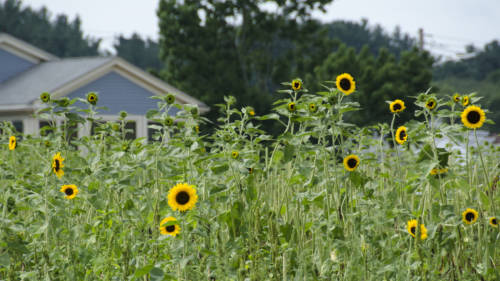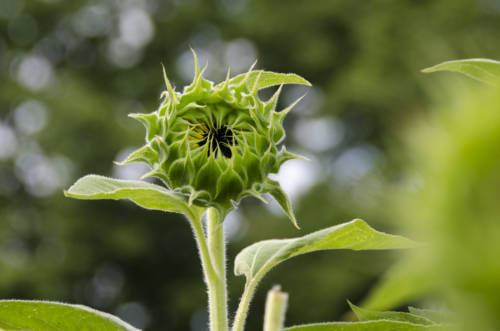
Scientists Are Using Sunflowers To Clean Up Nuclear Radiation
After the Hiroshima, Fukushima, and Chernobyl nuclear disasters, fields of sunflowers were planted across the affected landscapes to help absorb toxic metals and radiation from the soil. New research now suggests that sunflowers (Helianthus) might be as good for the environment as they are pretty to look at.
Sunflowers are what environmental scientists call hyperaccumulators– plants that have the ability to take up high concentrations of toxic materials in their tissues. Like all land-based plants, flowers have root systems that evolved as extremely efficient mechanisms for pulling nutrients, water, and minerals out of the ground, among them: zinc, copper, and other radioactive elements that are then stored in their stems and leaves.
While the sunflower-radiation link would seem like a slow-gestating cure-all for modern environmental disasters, the research is still inconclusive as to the efficacy of all sunflower varieties to help stave off environmental pollution. Post-tsunami clean-up efforts in Fukashima, however, demonstrate a promising application of this discovery.
One of the early successes in sunflower research came almost a decade ago when a phytoremediation company called Edenspace Systems completed a successful cleanup of a lead-laced plot in land in Detroit. (Phytoremediation is a technique for using plants to clean up contamination.)
“Sunflowers are what environmental scientists call hyperaccumulators– plants that have the ability to take up high concentrations of toxic materials in their tissues. They can absorb zinc, copper, and other common pollutants across of variety of their genome.”
In 2001, an article in the New York Times titled “New Pollution Tool: Toxic Avengers With Leaves” pointed out that sunflowers and Indian mustard were planted in contaminated land zones because they were known collectors of lead.
By the end of the test period, lead concentration in the soil was reduced by 43%, enough to bring pollution levels down below federal safety standards. While the project cost $900,000, a representative from the company pointed out that this was more than $1 million dollars cheaper than it would have been to remediate 5,700 cubic yards of soil by excavating and lugging the dirt to a hazardous waste landfill.
As of 2001, when the article was published, companies in the United States were spending more than $700 billion annually to clean up thousands of toxic sites. (It is easier to dispose of a field of sunflowers than it is to dig up thousands of tons of saturated, potentially-reactive soil.)
Much like the intestinal tract of a grown adult is several feet longer than most of us can comfortably imagine (it’s about 25 feet long) the Times reports that “the maze of roots and tiny root hairs of a single sunflower plant could total many miles”.
After a decade of field and greenhouse tests, a variety of techniques have emerged to shed light on the most effective application of sunflowers’ capacity to clean up nuclear radiation.
Perennial sunflowers have historically not been as popular as the domesticated sunflower, H. annuus, because of their tendency to become invasive. In the case of a nuclear cleanup, however, the flower’s capacity to spread rapidly is an asset: with a little assist from nature, an entire field can be neutralized (or at least, significantly remediated) within three years of planting. The flower grows best in woodlands and moist soils, like those near a waterway– another feature of every ecosystem that is categorically vulnerable to pollution.
The “sunflower fix” comes at a time of renewed interest in phytoremediation: in addition to breeding sunflowers that capture uranium, scientists have used the brake fern to clean up arsenic in Appalachian forests.
Certain alpine herbs have been also been studied for their ability to “hoard zinc” (quoth the Times) while some strands of mustard can take up lead, some strands of clovers eat oil, and yellow poplars can convert a toxic form of mercury to a more benign form. (According to research from the National Risk Management Research Laboratory of the Federal Environmental Protection Agency in Cincinnati, this breed of poplar can also destroy dry-cleaning solvents.)
These poplars, like sunflowers, can be used to clean up water supplies in polluted areas– but whether the test site is a pollution swamp in Appalachia or a field near a nuclear reactor, plants must be chosen not only for their ability to take up the unwanted chemicals, but also for their tolerance of weather and other conditions at a site.
Like any other crop, sunflowers must be adapted for local conditions– but because spreading seeds is cheap, non-invasive, and almost universally accessible, planting sunflowers is an ideally suited strategy for rapidly-industrializing parts of the developing world to mitigate the effects of pollution.
As the Times reports, sunflower-planted wetlands “from Ecuador to the Hudson River Valley are already cleaning up polluted water from landfills, slaughterhouses, cider mills, sewage plants, fish farms and parking lots [sic]”.
The extent of the sunflowers role as the most effective, non-invasive means to cleanup nuclear radiation remains yet unknown, but the promise and possibilities inherent to the plant’s biology are constantly revealing themselves. The sunflower is incidentally an international symbol for nuclear disarmament— yet another subtle indication that nature can indeed change the world.



































